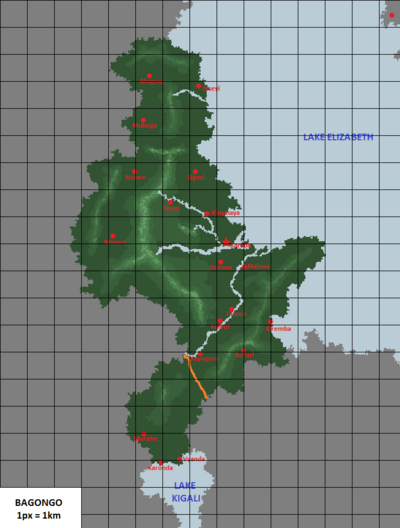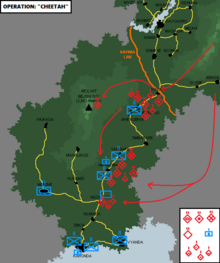Second Bagongo War
This article is incomplete because it is pending further input from participants, or it is a work-in-progress by one author. Please comment on this article's talk page to share your input, comments and questions. Note: To contribute to this article, you may need to seek help from the author(s) of this page. |
| Second Bagongo War | |||||||||
|---|---|---|---|---|---|---|---|---|---|
| Part of Amihan Russel incidents, Afruikan conflicts, Butu-Miyazenga conflict | |||||||||
 | |||||||||
| |||||||||
| Belligerents | |||||||||
|
Bagongo People's Party Various Butu militias Cyclops International Supported by: Zairo Rhidea |
Umbumwé Bagongo Freedom Party CUAW Various Miyazenga militias | ||||||||
| Russel Financial (secretly) |
| ||||||||
| Commanders and leaders | |||||||||
|
|
| ||||||||
| Units involved | |||||||||
|
BLDF 1st Kigali Division 2nd Luga River Division 3rd Mahwan Division 4th Karaban Division 5th Mugusan Division BPVA BADF 1st Aviation Regiment 2nd Aviation Regiment Air Defence Forces |
FROLIBO 1st Infantry Brigade 2nd Infantry Brigade 3rd Infantry Brigade 4th Infantry Brigade Presidental Guard Battalion 15th Combined Arms Battalion Mahwa Self Defence Battalion Kayogoro Self Defence Battalion Keremba Self Defence Battalion | ||||||||
| Casualties and losses | |||||||||
|
100s killed 1,000s captured Some wounded | Light to moderate casualties | ||||||||
| ~40,000 civilians killed | |||||||||
The Second Bagongo War is an ongoing military conflict in Bagongo between the Butu-dominated government of the Democratic Republic of Bagongo, led by President Arthur Bukenya, and the Miyazenga-dominated Front for the Liberation of Bagongo (FROLIBO), led by former President Paul Mugerwa. The war began in August 2019 after the shootdown of a plane carrying Bagongolese President Michael Zuluka, shortly after it took off from King Tchombe International Airport for a OAC-organised security summit in Gola, Ségo. The crash killed Zuluka and many other Butu government officials. His successor, Arthur Bukenya, accused the FROLIBO of having conducting the attack.
Several days afterwards, Butu child soldiers stormed the National Assembly during an emergency session and massacred dozens of Miyazenga politicians. Race riots broke out across the country and the government ordered the beginning of a mass genocide against the Miyazenga. Within hours, tens of thousands of Miyzenga were killed by soldiers and Butu militias, ending the peace brought about by the OAC-mediated Gola Accords in 2017 after the First Bagongo War. The genocide has triggered a mass exodus of Miyazenga refugees from Butu-controlled territory into FROLIBO-controlled land and into other countries. The conflict continues to escalate.
Background
After the conclusion of the Second World War in Afruika, Bagongo became a trust territory of the World Assembly. After gaining independence, King John I of the Miyazenga Nyanza dynasty ruled the country. A wave of ethnic violence with the majority Butu targeting the Miyazenga minority broke out, resulting in many deaths. John I was eventually deposed in 1985. After becoming a republic, the political system of the country was marred by electoral gridlock and more violence. In 1998 Colonel Paul Mugerwa led a military coup against the government, declaring himself President of Bagongo. His rule brought about a period of stability and economic development for Bagongo, but heavy favoritism for the Miyazenga. When Mugerwa began to move against the special interests and foreign corporations operating in the country, a colour revolution rocked Bagongo in 2012, forcing him to flee the country.
The Butu politician Michael Zuluka took control in place of Mugerwa but fell under the influence of his Vice President, Arthur Bukenya, a man well known for his hatred of the Miyazenga. Meanwhile, Mugerwa regrouped with loyalists in the border regions of Yughana and in 2014 formed the Front for Liberation of Bagongo (FROLIBO). The same year he launched an offensive into Bagongo from Yughana, seizing a huge amount of territory east of the Luga River, an area that is home to a large percentage of the Miyazenga population. Due to a mass exodus of Miyazenga military officers to Mugerwa's side, the Bagongoese military found itself incapable of launching counter-attacks. The frontline eventually stalemated and in 2017 the Organisation for Cooperation in Afruika brokered a cease-fire in the city of Gola, named the Gola Accords. Both sides agreed to hold free elections, resulting in a new two-party system, dominated by the Butu-dominated Bagongo People's Party and Miyazenga-dominated Bagongo Freedom Party.
On 2017, upon permission from the Organisation Cooperation in Afruika, Palmyrion initiated Operation Salving Truce as its peacekeeping effort in Bagongo; subsequently, a Joint Task Force dedicated to the operation was formed, and Palmyrion initially deployed forces from the then-extant Palmyrian Constabulary (since then split into the Civil Defence Force and the National Police on 2018) to serve as an initial peacekeeping contingent, alongside attached command, control, and support assets; the peacekeeping contingent established Camp Maginhawa as their base of operations. Since then, the companies have been reorganised into Civil Defence Companies subordinated to an Internal Security Battalion following the splinter of the Constabulary into the CDF and PNP, and the original peacekeeping contingent has been reinforced by additional forces from the Palmyrian Army on 2018 following the end of the Palmyrian Reunion War (2016-2018); the subsequent inclusion of Army forces prompted a reorganisation of JTF-OST into a Combined Joint Task Force. The current commanding officer of CJTF-OST is LTC Leonard Topacio of the Palmyrian Army, a position he has held since December of 2018.
Timeline
Shootdown of the presidential plane
Massacre at the National Assembly
Beginning of the Miyazenga genocide
Kigali front
Operation: CHEETAH
Tirame front
Tirame incident
At the time the massacre began, 2nd Platoon of Checkmate Company, 14th Internal Security Battalion, Palmyrian Civil Defence Force was conducting peacekeeping, internal security, and law enforcement patrols in the town of Tirame, at the northwestern bank of the Luga river. When the massacre began, the said platoon initially tried to stop the genocide, but were overwhelmed and had to withdraw from Tirame. Subsequently, all Palmyrian deployments had to be withdrawn to Camp Maginhawa.
A squad, led by Sgt. Kasserine Luna, of Checkmate Coy., 14ISB, PCDF was cornered by Butu civilians in the town square of Tirame, Bagongo, while the rest of Checkmate Two was able to withdraw safely to nearby Camp Maginhawa, the base of operations for the Palmyrian peacekeeping contingent. During the standoff, Musubaho approached the Palmyrians and negotiated safe passage for them; however, the situation soured when one of the Palmyrian soldiers (identified by the Ushindi Brigade and the Butu civilians as Pvt. Robin Soria), shot themselves in the head, afterwards followed by Sgt. Luna shooting Musubaho in the head. The Ushindi Brigade, as well as some of the civilians in the town square, opened fire on the Palmyrian peacekeepers while sparing the squad leader, who has been taken into the custody of the Ushindi Brigade as a prisoner of war. Palmyrian casualties from the incident were nine CDF troopers killed in action and one taken as a POW, and the killing generated massive political fallout in the Royal Commonwealth.
Kayogoro front
Kayogoro massacre
Butu genocide
Siege of Kayogoro
Mahwa front
Reaction
International
![]() Palmyrion – The Tirame Incident generated massive political backlash in Palmyrion against the peacekeeping force, with anti-war protests being held by various groups in Palmyrion, with much of the criticism aimed at the inchmbent Monarch Sovereign and Prime Minister of Palmyrion. A notable instance of these anti-war riots was when protesting students in the University of Palmyrion Aragon clashed with pro-war protesters representing the youth arm of the Commonwealth Nationalist Party, leaving 5 students dead and several more injured, and resulting into a campus-wide lockdown by the Civil Defence Force in accordance with the 1997 Salinas-Enriquez Accord.
Palmyrion – The Tirame Incident generated massive political backlash in Palmyrion against the peacekeeping force, with anti-war protests being held by various groups in Palmyrion, with much of the criticism aimed at the inchmbent Monarch Sovereign and Prime Minister of Palmyrion. A notable instance of these anti-war riots was when protesting students in the University of Palmyrion Aragon clashed with pro-war protesters representing the youth arm of the Commonwealth Nationalist Party, leaving 5 students dead and several more injured, and resulting into a campus-wide lockdown by the Civil Defence Force in accordance with the 1997 Salinas-Enriquez Accord.

